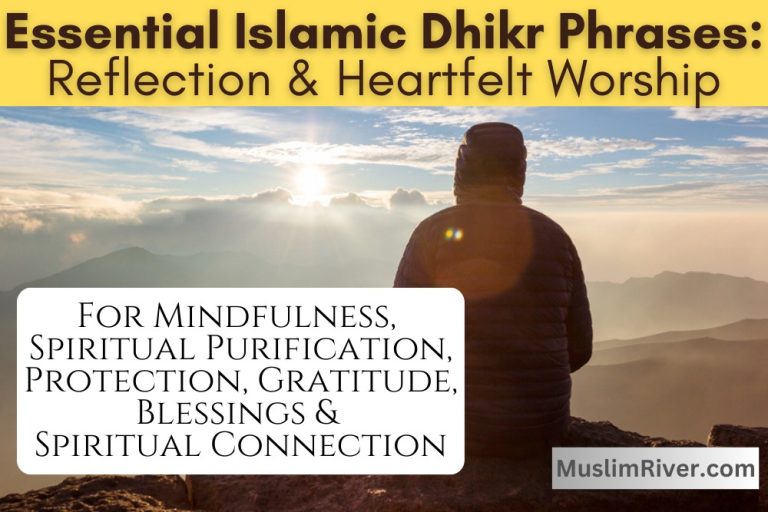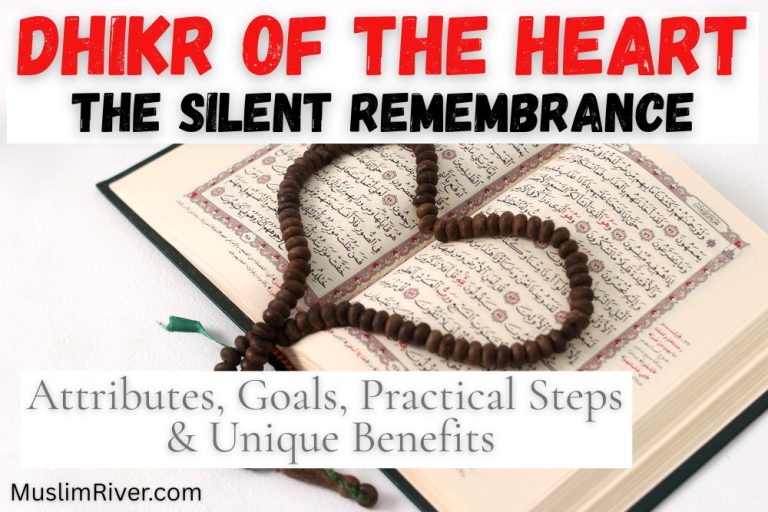Historical Evolution of Dhikr Practices Among Muslims
Introduction
In a world overshadowed by constant distractions, many Muslims long for a deeper connection to their faith.
For this blogpost, Islamic texts are studied, reliable historical sources are consulted, and findings are organized in a clear format ensuring both depth and practicality.
In this post, we dig into Dhikr’s prophetic origins, explore its integration in early Islamic communities, highlight key scholarly insights, and examine its modern adaptations across various cultures.
By exploring Dhikr’s historical foundations, you’ll refine your daily remembrance, deepen your Divine connection, and discover lasting peace through a transformative spiritual practice.
Keep reading to uncover a powerful Dhikr-based checklist at the end—an exclusive resource designed to elevate your personal practice.

Origins of Dhikr: Its Role in Early Islamic Spirituality
Have you ever wondered how the profound practice of Dhikr began in the Islamic faith?
I’ll guide you through the foundational stages of Dhikr, from the Prophet’s practices to its cultural integration, clearly showing how each phase enriches your understanding and deepens your spiritual practice today.
1. Prophetic Beginnings: The practice of Dhikr traces back to the early spiritual life of Prophet Muhammad (peace be upon him), even BEFORE his prophethood.
Known for his contemplative retreats to the cave of Hira, the Prophet engaged in deep reflection and meditation, seeking truth and understanding.
These solitary sessions, marked by profound spiritual contemplation, set the stage for what would later become formalized Dhikr after the revelation of the Qur’an.
After becoming a prophet, he introduced and emphasized various Dhikr practices to his followers, reinforcing their spiritual connection with Allah:
- Tasbih (SubhanAllah), acknowledging Allah’s perfection.
- Tahmid (Alhamdulillah), expressing gratitude to Allah.
- Takbir (Allahu Akbar), declaring Allah’s greatness.
- Tahlil (La ilaha illallah), affirming Allah’s oneness.
- Salat (Prayer), establishing the five daily prayers as the best form of Dhikr.
- Dua (Supplication), encouraging personal prayers to Allah.
- Qur’an Recitation, promoting the regular reading of the Qur’an.
- Specific Dhikr for Morning and Evening, for continuous remembrance.
- Dhikr After Prayers, to reinforce remembrance post-salat.
- Dhikr in Gatherings, transforming social interactions into spiritual sessions.
These teachings underscore the central role of Dhikr in Islamic spirituality, showing its accessibility and profound spiritual benefits.
His guidance on these practices provided a comprehensive framework for Muslims to maintain a constant connection with Allah, integrating Dhikr seamlessly into every aspect of their daily lives.
He emphasized its importance for spiritual elevation, as reflected in multiple hadiths.
Arabic: مَنْ قَالَ سُبْحَانَ اللَّهِ وَبِحَمْدِهِ مِائَةَ مَرَّةٍ غُفِرَتْ لَهُ ذُنُوبُهُ وَإِنْ كَانَتْ مِثْلَ زَبَدِ الْبَحْرِ
Translation: Abu Hurairah narrated that : The Messenger of Allah (ﷺ) said: “Whoever says: ‘Glory is to Allah, and with His Praise (Subḥān Allāh, wa biḥamdih)’ a hundred times, his sins are forgiven, even if they were like the foam of the sea.”
The Qur’an frequently emphasizes Dhikr, with numerous verses advocating the believers to remember Allah.
For instance:
Arabic: وَاذْكُرْ رَبَّكَ فِي نَفْسِكَ تَضَرُّعًا وَخِيفَةً وَدُونَ الْجَهْرِ مِنَ الْقَوْلِ بِالْغُدُوِّ وَالْآصَالِ وَلَا تَكُن مِّنَ الْغَافِلِينَ.
Translation: Remember your Lord inwardly with humility and reverence and in a moderate tone of voice, both morning and evening. And do not be one of the heedless.
Arabic: الَّذِينَ آمَنُوا وَتَطْمَئِنُّ قُلُوبُهُم بِذِكْرِ اللَّهِ أَلا بِذِكْرِ اللَّهِ تَطْمَئِنُّ الْقُلُوبُ.
Translation: those who believe and whose hearts find comfort in the remembrance of Allah. Surely in the remembrance of Allah do hearts find comfort.
Source: Surah Ar-Ra’d – 1-43 – Quran.com
2. Companion Practices: The companions of Prophet Muhammad (peace be upon him), including pivotal figures like Abu Bakr as-Siddiq and Ali ibn Abi Talib, were instrumental in embedding Dhikr deeply within the fabric of early Islamic life.
Their integration of Dhikr into daily practices not only demonstrated its widespread acceptance among the early believers but also highlighted its profound spiritual significance.
ABU BAKR AS-SIDDIQ, known for his deep devotion, often led gatherings in Dhikr, using it as a tool to foster spiritual awareness and unity among Muslims.
His practice of Dhikr was marked by a profound sincerity, reflecting his close relationship with the Prophet and his earnest desire to emulate his spiritual practices.
ALI IBN ABI TALIB, renowned for his wisdom and spiritual depth, taught that Dhikr was a portal to divine presence and knowledge.
His teachings often included detailed explanations of the virtues of Dhikr, encouraging the believers to engage in it continuously.
Under his guidance, Dhikr sessions became a common practice, where participants deeply immersed themselves in the remembrance of Allah, seeking spiritual elevation and inner peace.
These gatherings were not merely ritualistic; they were vibrant communal activities that strengthened the bonds among the early Muslims.
Anas bin Malik [may Allah be pleased with him] narrated that the Messenger of Allah said:
Arabic: ” إِذَا مَرَرْتُمْ بِرِيَاضِ الْجَنَّةِ فَارْتَعُوا ” . قَالَ وَمَا رِيَاضُ الْجَنَّةِ قَالَ ” حِلَقُ الذِّكْرِ ”
Translation: When you pass by the gardens of Paradise, them feast.” They said: “And what are the gardens of Paradise?” He said: “The circles of remembrance.
Historical accounts describe how these sessions were conducted in mosques and homes, often after the daily prayers, and how they served as spiritual sanctuaries where the community came together to connect with Allah.
The collective atmosphere of these Dhikr sessions enhanced the participants’ spiritual experiences and solidified their communal bonds, playing a crucial role in the cohesion and identity of the early Muslim community.
3. Early Theological Insights: The early Islamic period was marked by profound theological exploration, during which several scholars provided crucial insights into the practice of Dhikr.
Notable among these were Hasan al-Basri, Al-Junayd of Baghdad, and Imam Al-Ghazali, whose works significantly shaped the Islamic understanding of Dhikr.
HASAN AL-BASRI, a revered early Muslim scholar and mystic, emphasized the purifying power of Dhikr, teaching that it cleanses the heart and brings the believer closer to Allah.
His sermons and teachings, which attracted large followings, often discussed how Dhikr serves as a spiritual shield against sin and a means to enhance one’s consciousness of Allah.
AL-JUNAYD OF BAGHDAD, known as one of the founders of Sufism, offered deeper mystical insights into Dhikr.
He described it as a means to transcend the physical world and attain direct experience of the divine. Al-Junayd’s approach to Dhikr involved profound contemplation that went beyond mere repetition of words, aiming for a transformative spiritual experience.
IMAM AL-GHAZALI, later in the Golden Age of Islam, wrote extensively on Dhikr in his seminal work, “Ihya’ ‘Ulum al-Din” (The Revival of the Religious Sciences).
He systematically categorized Dhikr practices and elaborated on their benefits, advocating Dhikr as essential for achieving spiritual enlightenment and closeness to Allah.
Al-Ghazali’s teachings helped formalize Dhikr practices within Islamic education, making them accessible and systematic for scholars and laypeople alike.
These scholars’ discussions and writings did not merely address the practical aspects of Dhikr; they delved into its spiritual dimensions, offering insights that have continued to influence Islamic spiritual practices to this day.
Their work underscores the rich theological tapestry of early Islam and highlights the enduring significance of Dhikr in cultivating a profound connection with the divine..
4. Cultural Integration: Dhikr was not only a spiritual practice but also a significant cultural element in early Islamic societies.
Its integration into daily life helped shape the social and cultural landscape of the Muslim community during the formative years of Islam.
From the bustling markets of Damascus to the scholarly circles of Baghdad, Dhikr became a ubiquitous aspect of everyday life.
It was common for traders to recite Dhikr while conducting their business, reinforcing ethical conduct and mindfulness of Allah amidst their transactions.
Similarly, craftsmen and artisans would integrate Dhikr into their work routines, viewing their craftsmanship as an act of worship through continuous remembrance of Allah.
In the educational realm, Dhikr was a fundamental component of the curriculum in madrasas (Islamic schools).
Furthermore, Dhikr played a vital role in social gatherings and celebrations.
During weddings, births, and even funerals, Dhikr was performed to bless the occasions and invoke Allah’s mercy and blessings.
These communal Dhikr sessions served to unify the community, fostering a shared spiritual identity and reinforcing social bonds among its members.
These sessions often involved recitations of Qur’anic verses and prophetic sayings, resonating through the community and fostering a unified spiritual ambiance.
Understanding the origins of Dhikr is not just about tracing historical facts; it’s about connecting with a tradition that has shaped the spiritual lives of millions.
By knowing its early importance and integration into daily life, you gain a more profound respect and comprehension of how Dhikr can serve as a bridge to enhanced spiritual enlightenment and personal peace.
Dhikr’s Development in Islamic Golden Age
Dhikr began not just as a spiritual exercise but as a revolutionary act in the spiritual lives of early Muslims.
I’ll introduce you to the key figures who pioneered Dhikr, delve into the theological insights they provided, and explore the scholarly work that has preserved this practice, helping you connect more deeply with your spiritual roots.
The Islamic Golden Age spanned roughly from 750 to 1258 CE, during the height of the Abbasid Caliphate.
Centered in Baghdad, this era was marked by major advancements in science, medicine, philosophy, theology, and the arts.
Institutions like the House of Wisdom played a key role in translating and preserving knowledge from Greek, Persian, and Indian sources. Scholars such as Ibn Sina, Al-Ghazali, and Alhazen made lasting contributions that shaped both Islamic and global intellectual history.
The period came to a symbolic end with the Mongol sack of Baghdad in 1258, but its influence on Islamic thought, including spiritual practices like Dhikr, continues to resonate today.
1. Key Figures: During the Islamic Golden Age, pivotal figures such as Ibn Sin, Al-Ghazali, Rumi, and Ibn Arabi profoundly shaped the practices and perceptions of Dhikr, each bringing unique perspectives that deeply influenced Islamic spiritual culture.
AL-GHAZALI
- Renowned as the “Reviver of Islam”, Al-Ghazali emphasized the centrality of Dhikr in his seminal work Ihya’ ‘Ulum al-Din (The Revival of the Religious Sciences) Al-Ghazali | Biography, History, Philosophy, & Books | Britannica .
- He taught that Dhikr is essential for purifying the soul and achieving nearness to Allah.
- His approach was highly methodical, blending traditional Islamic scholarship with Sufi mysticism, which allowed his teachings to resonate with both scholars and spiritual seekers across the Muslim world.
IBN ARABI
- In his monumental work Futuhat al-Makkiyya (The Meccan Revelations), Ibn Arabi look into the metaphysical and experiential dimensions of Dhikr Ibn al-ʿArabī | Muslim Mystic, Sufi Philosopher | Britannica .
- He viewed Dhikr as a path to direct experience of the Divine Presence, where remembrance becomes a mirror for unveiling deeper truths of existence.
- His esoteric and philosophical insights shaped generations of mystics and spiritual scholars, elevating Dhikr as a means of divine realization.
RUMI (JALAL AD-DIN RUMI)
- Through his mystical poetry, especially in the Masnavi, Rumi made Dhikr emotionally accessible and spiritually uplifting to wider audiences Rūmī summary | Britannica .
- He often integrated Dhikr with dance, music, and poetic rhythm to express spiritual ecstasy.
- His approach was revolutionary, turning Dhikr into a communal and aesthetic experience that transcended conventional ritual forms.
2. Theological Impact: The Golden Age was a period of intense intellectualism that significantly influenced theological discussions around Dhikr.
Scholars debated its role in achieving Ma’rifah (gnostic knowledge) and its transformative impact on the soul’s journey towards divine proximity.
This era enriched the Islamic intellectual tradition with a deeper understanding of Dhikr, elaborating on its philosophical and spiritual implications.
3. Scholarly Works: Al-Ghazali’s “Ihya’ ‘Ulum al-Din” is notable not just for its content but for how it structured Dhikr within the life of a Muslim, prescribing it as a spiritual practice essential for overcoming the ego and attaining inner peace.
His work remains a cornerstone in Islamic teachings on spirituality.
Rumi’s “Diwan-e Shams-e Tabrizi” highlights Dhikr as a powerful means to transcend the physical realm and connect with the spiritual.
His poetic expressions of Dhikr have inspired countless individuals to explore Sufism and the deeper spiritual dimensions of Islam.
Ibn Arabi’s “Futuhat al-Makkiyya” provides extensive metaphysical insights into Dhikr, portraying it as a bridge between the human and the divine.
His philosophical treatises have been pivotal in shaping the Sufi metaphysical discourse about the nature of reality and the experience of the divine.
Understanding the key figures, theological impacts, and scholarly contributions to Dhikr not only deepens your knowledge but also connects you to a broader narrative of Islamic spirituality.
This exploration offers a chance to appreciate the depth and evolution of this practice, highlighting its enduring relevance and transformative power within the Muslim community.
Islamic Dhikr’s Development in Modern Times
Imagine being in a time when Dhikr was not just a personal act but a field of vibrant scholarly debate and spiritual exploration.
Let me show you how Global advancements and the movements of Muslim communities around the globe have played pivotal roles in shaping modern Dhikr practices, offering you a comprehensive view that could inspire new dimensions in your spiritual life.
1. Global Spread and Institutionalization: Thanks to colonialism, migration, and globalization, Dhikr-based spiritual practices—especially those connected to Sufism—spread across continents and took on new regional and cultural expressions, including.
- Group Dhikr gatherings in North America, Europe, and Southeast Asia
- Formal Dhikr circles (Halaqat adh-Dhikr) within Islamic centers and mosques
- Dhikr events tied to interfaith dialogues, spiritual wellness, or trauma recovery
2. Academic and Theological Revival: Scholars and thought leaders have contributed to the revival of Dhikr as a spiritually rich, intellectually credible practice:
- Translations and commentaries of classical works (e.g., Al-Ghazali’s Ihya) are now widely available.
- Modern Muslim psychologists emphasize Dhikr as a form of spiritual mindfulness, beneficial for mental and emotional well-being.
- Islamic studies programs and public lectures often integrate Dhikr with broader conversations on spiritual growth, emotional intelligence, and purposeful living.
3. Balancing Tradition and Innovation: While modern tools and formats have helped revitalize Dhikr, many scholars emphasize the importance of grounding practices in Qur’anic and Prophetic guidance. There’s a rising call to:
- Maintain authenticity (e.g., morning/evening adhkar, dhikr after salah)
- Reconnect with the Prophetic model of remembrance
- Avoid excess or innovation (bid’ah) in form or content while embracing cultural relevance and emotional depth.
Understanding how technological advancements and the movements of Muslim diasporas have influenced Dhikr underscores the adaptability and resilience of this spiritual practice.
This insight offers not only a deeper appreciation for its historical evolution but also highlights the relevance of Dhikr in the modern world, connecting traditions with contemporary spiritual needs.
Frequently Asked Questions
How Was Dhikr Integrated Into the Cultural and Social Life of Early Muslims?
Dhikr was a fundamental part of early Muslim life, practiced both individually and in groups.
It was embedded in daily routines and communal gatherings, helping to strengthen community bonds and reinforce Islamic identity and values.
What Are Some of the Theological Insights From Early Islamic Scholars Regarding Dhikr?
Early scholars like Al-Ghazali emphasized Dhikr’s role in purifying the heart and achieving closeness to Allah.
They highlighted its psychological benefits, such as bringing peace to the heart and acting as a spiritual discipline that enhances the practitioner’s relationship with the divine.
Conclusion
The transformation of Dhikr across eras highlights its adaptability and enduring relevance.
As we have compared its practices from the Prophet Muhammad’s era to the Islamic Golden Age and through to the modern digital world, it’s clear how Dhikr has consistently adapted to meet the spiritual needs of Muslims across the globe.
This analysis not only enriches our understanding of Dhikr’s historical depth but also empowers us to appreciate and integrate this versatile practice into our daily lives.
By embracing the lessons from the past, we ensure that Dhikr remains a vital part of our spiritual identity, helping us to maintain a conscious connection with our faith in a rapidly changing world.
We’d love to hear your thoughts and experiences with Dhikr.
Please leave a comment on our blog post and subscribe to our email list to stay updated with more insightful content like this.






